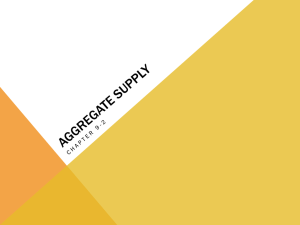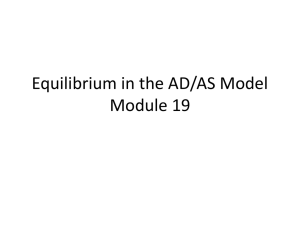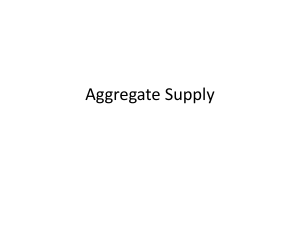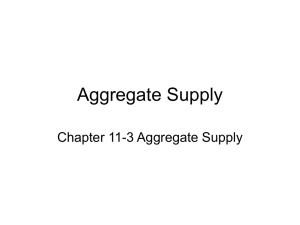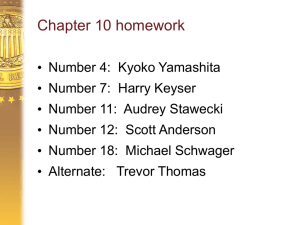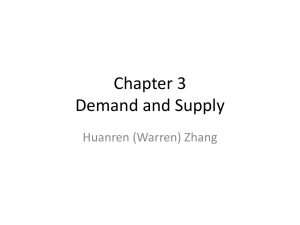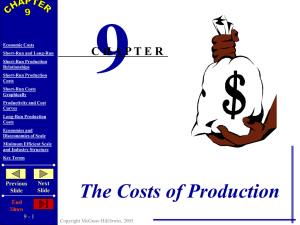10 AS-AD Model
advertisement
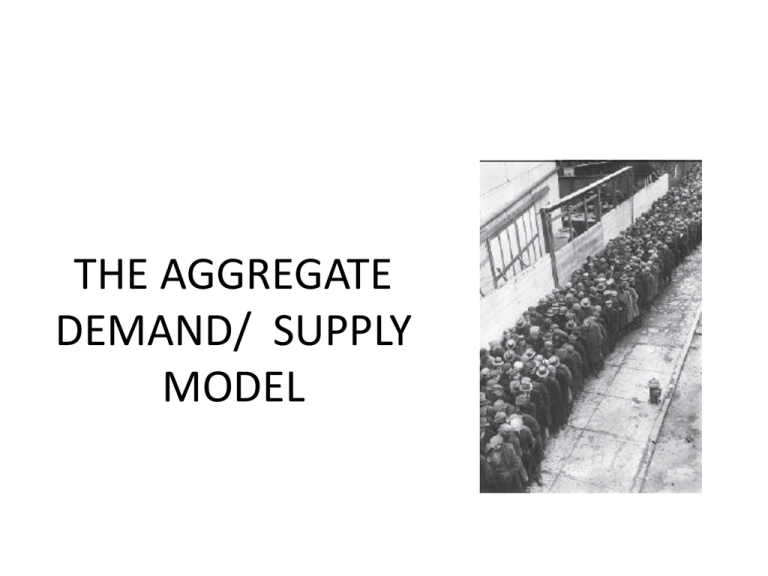
THE AGGREGATE DEMAND/ SUPPLY MODEL The U.S. Great Depression • 1929-1939 – Output fell by 30% – Unemployment as high as 25% – Prices declined 30% in the first four years • Led to the development of modern macroeconomic theory Video 9-2 Before: Classical Economics • Focused on long-run issues--growth • Self-regulating markets through the “invisible hand” – Prices would adjust during recessions – Economy would always return to its potential output in the long-run • Depression caused by institutions that prevented prices from falling, specifically: – Labor unions – Government • Advocated a laissez-faire (hands-off) economic policy 9-3 After: Keynesian Economics • John Maynard Keynes in The General Theory of Employment, Interest, and Money (1936) • Problems of the Depression required a short-run, rather than long-run, focus. 9-4 Keynesian Economics • Adjustments to equilibrium for a single market and the aggregate economy are different. • Short-run equilibrium income may differ from long-run potential income. • Paradox of thrift – In long run, saving leads to investment and growth. – In short run, saving may lead to a decrease in spending, output, and employment. • Aggregate demand management by government may be 9-5 necessary. Keynesian Economics and the AS/AD Model • Aggregate Demand Curve (AD) – Relates changes in the price level to changes in aggregate expenditures = C + I + G + (X-M) • Short-Run Aggregate Supply Curve (SAS) – Relates changes in the price level to changes in aggregate supply. • Long-Run Aggregate Supply Curve (LAS) – Shows potential output at any point in time 9-6 The Aggregate Demand Curve Wealth, interest rate, and international effects P0 Multiplier effect P1 AD 9-7 Y0 Y1 Ye Real output Shifts in the AD Curve Initial effect = 100 increase in expenditures Price level Multiplier effect = 200 Change in total expenditures = 300 P0 100 200 AD0 9-8 AD1 Real output The Short-Run Aggregate Supply Curve Price level SAS Real output 9-9 Shifts in the SAS Curve SAS1 1. Higher input prices 2. Higher import prices Price level 3. Higher sales and excise taxes 4. Reduced productivity SAS0 Real output 9-10 Long-Run Aggregate Supply Curve LAS LAS1 • LAS curve shows potential output • Vertical because potential output Price Level is unaffected by the price level. • Increases in capital, resources, Potential output Real output 9-11 growth-compatible institutions, technology, and entrepreneurship increase potential output and shift LAS to the right. LAS Curve LAS • Potential output is assumed to be the middle of a range bounded by high and low levels of potential output. C • When resources are over-utilized Price Level B A Underutilized resources (point C), factor prices may be bid up SAS When resources are under-utilized (point A), factor prices may be bid down Overutilized resources • When LAS = SAS (point B), there is Low-level potential output 9-12 High-level potential output Real output no pressure for prices to rise or fall. Short-Run Equilibrium: Changes in AD • Short-run equilibrium is Price level where SAS = AD0 (point E). SAS P1 P P00 F E AD1 AD0 Y Y00 9-13 Y1 Real output • If AD increases to AD1, equilibrium output increases to Y1 and the price level increases to P1. Short-Run Equilibrium: Changes in SAS Price level • Short-run equilibrium is SAS1 G P1 SAS0 E P0 AD Y1 9-14 Y0 Real output where SAS0 = AD (point E). Equilibrium output is Y0 and the price level is P0. • If SAS increases to SAS1, equilibrium output decreases to Y1 and the price level increases to P1 (point G). Long-Run Equilibrium Price level LAS • Long-run equilibrium is H P1 P0 point E where AD0 = LAS. Equilibrium output is at potential output YP and the price level is Po. E AD1 AD0 YP 9-15 Real output • An increase in AD to AD1 increases the price level to P1 but output is unchanged at YP. Integrating Short-Run and LongRun Frameworks • The economy is in long-run Price level LAS E and short-run equilibrium at point E where AD=SAS=LAS and output is YP and the price level is P0. SAS • AD grows at the same rate P0 AD 9-16 YP Real output as potential output, so that unemployment and inflation are very low. Recessionary Gap • A recessionary gap is the LAS amount by which equilibrium output is below potential output. Price level • At point A, some resources are SAS0 A P0 AD Recessionary gap Y1 9-17 YP Real output unemployed and the recessionary gap is YP – Y1. Inflationary Gap • An inflationary gap is the Price level LAS amount by which equilibrium output is above potential output. • If the economy is at point C, C P0 SAS0 AD Inflationary gap YP 9-18 Real Y2 output resources are being used beyond their potential and the inflationary gap is Y2 – YP. Expansionary Fiscal Policy Price level • Economy is at equilibrium LAS at A, there is a recessionary gap Y0 – YP. • Appropriate fiscal policy is B SAS P1 P0 AD1 A • AD increases to AD1 and AD0 9-19 Y0 to increase government spending and/or decrease taxes. YP Real output output returns to potential output YP and prices increase slightly to P1. Contractionary Fiscal Policy LAS • Economy is at equilibrium at Price level B, there is an inflationary gap Y2 – YP. B P2 • Appropriate fiscal policy is to AS AD0 AD2 YP 9-20 Y2 Real output decrease government spending and/or increase taxes. • AD0 decreases to AD2 and output returns to potential output YP and inflation is prevented. Macro Policy Problems • Implementing fiscal policy – Slow legislative process – Slow and uncertain reaction by the economy • Avoiding “over-correcting” 9-21
